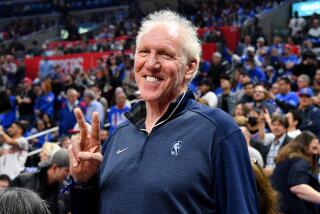With Ankton, the Handicap You Notice Is 2
SAN DIEGO — Sammy Davis Jr. used to tell this one on himself at celebrity golf tournaments when people asked him for his handicap:
“I’m a black, Jewish Democrat with one eye,” was Davis’ stock answer.
Times changed, and Davis’ one-liner, cute to some people in the ‘50s and early ‘60s, wore thin later on, when social consciousness heightened.
But the fact was this: Davis was not a very good golfer. Oceanside’s Glenn Ankton is.
Ankton is black and wears prosthetic devices on both legs because he stepped on a land mine in Vietnam 20 years ago.
The explosion threw him 10 feet in the air. For a second, Ankton thought he was dead. Then he felt the white-hot pain. That told him he was still alive.
When a medic finally arrived, he told Ankton not to look. Ankton told the medic it didn’t matter. He knew his legs were gone. He knew he would be permanently disabled.
None of which has anything to do with Ankton’s handicap.
By the latest computations of the Southern California Golf Assn., Ankton’s golf handicap is 2.
That means if he plays against a perfectly healthy, normal, red-blooded American male with an 11 handicap, Ankton must give him one shot every other hole.
That doesn’t sound fair.
But when he’s on his game, Ankton, 40, can hit his metal driver 290 yards. When he’s right, he can hit his seven-iron 180 yards. When he gets all of it, he can hit his pitching wedge 140 yards.
That doesn’t sound fair, either.
Fair has nothing to do with Ankton’s life. He grew up on the same mean streets of Detroit that produced boxer Thomas Hearns.
Like Hearns, he had quick hands. And even though he weighed only 140 pounds, he could hit a baseball farther than anybody else his age. Ankton’s forearms were disproportionately large. His friends called him “Popeye.”
But when the Detroit race riots erupted in the late ‘60s, Ankton decided he wanted out. His brother told him to enlist in the Army. If he joined the Marines, his brother said, he would be dodging bullets in Vietnam quicker than you can say “Duck, Charlie.”
Ankton joined the Marines anyway.
“At least I’ll have fire support,” he told his brother.
The next thing he knew, he found himself in the middle of the living nightmare known as the Tet offensive. On one occasion, a sniper felled the man standing to his left with a bullet to the head. An instant later, the man standing to his right stopped a bullet with his head.
Ankton figured he was just lucky. Until he stepped on the land mine. He no longer had any legs below the knees. “I used to be 6-4,” is the way he puts it now.
For the longest time, he was in and out of VA hospitals trying on wooden legs, testing rubberized prosthetic devices and sitting in wheelchairs for weeks on end every time one of his artificial legs broke.
His dream of playing major league baseball had ended. But he didn’t dwell on his misfortune.
“It never bothered me from the time it happened,” he says. “And it hasn’t bothered me yet.”
Ten years passed, and Ankton gradually got his life back together. He lived in New Britain, Conn., where he had a job, a wife, a daughter, a son and lots of friends.
One muggy, early summer New England evening, Ankton and his buddies threw back a couple of beers and drove out to the local pitch-and-putt just for grins. It was one those places where they hand you a putter, a wedge and a ball at the cash register. No hole was longer than 100 yards.
Soon they were playing pitch-and-putt every night. And Ankton found these games were replacing the competitive void that had been gnawing at him since he lost his legs.
Then they moved to a par-three course where the holes were a little longer. Next Ankton was sneaking out to a driving range. One of the pros at the range offered a few pointers. And, says Ankton, “I just kept hitting ‘em and hitting ‘em and hitting ‘em.”
To this day he will beat as many as 500 practice balls a session. There are times when he can’t close his hands into a fist when he gets home. Most nights he can’t wait to unharness his legs, which are attached above the knee.
“It’s like taking off a pair of hiking boots after you’ve been hiking all day,” he says. “It’s like a big relief.”
The farther he tried to hit the ball that first summer, the harder it was to maintain his balance. So he got a pair of golf shoes. The spikes helped anchor his body.
His natural arm strength, a full shoulder turn and the quickness in his hands were more than enough to produce the distance necessary to start reaching the shorter par fives in two.
The following summer, he was shooting in the 80s. The summer after that, his scores started dropping into the 70s. In 1981, he won the National Amputee Open.
Last November, Ankton had seven birdies and saved par at the 18th hole with a six-foot putt to the tie the course record of 66 at Camp Pendleton’s Memorial Course.
Two months later, he was teeing it up with PGA touring professional Tom Sieckmann, XTRA radio boss John Lynch and Steve Ortmayer, the Chargers’ director of football operations, in the Shearson Lehman Hutton Pro-Am at Torrey Pines.
Ankton’s team finished 15th out of 40 teams with a net 61. A minor disappointment. Just playing in front of crowds, surrounded by the world’s best golfers, fulfilled one of Ankton’s golfing dreams.
Another of those dreams is that he will someday be good enough to play on the PGA Seniors Tour. He will be eligible in 10 years.
The list of golfers who also will be eligible for the seniors tour by then is a daunting one. It includes Jack Nicklaus and Lee Trevino (both of whom turn 50 within the next six months), Johnny Miller, Larry Nelson, Tom Kite and Raymond Floyd. Just to name a few.
But don’t tell Ankton he can’t.
“It makes me mad when somebody says they can’t do something,” he says. “It’s never been in my vocabulary that I can’t do something.”
But that doesn’t mean Ankton doesn’t occasionally spar with his game, just like all other golfers. Great Britain’s Sandy Lyle, the 1988 Masters champion who has struggled mightily in the States this year, recently shot a 64 to lead after the first round of the Irish Open.
Afterward somebody asked Lyle how he could miss the cut at the U.S. Open and shoot a 64 less than a week later.
“Golf,” Lyle said with a sigh, “is a daft game.”
But deft is what you need to be with your short game when your driver deserts you. It happened to Ankton last week at the neatly manicured but tight Lomas Santa Fe Country Club course in Solana Beach.
Ankton fought a “block-push” off the tee all day that resulted from his desire to avoid hooking the ball out of bounds. His short game saved him on several holes.
But the measure of his talent emerged on the 18th hole, a 200-yard par three that, against the wind, played more like 225 on this day. The 18th also rises to an elevated green, which means the shot is all carry.
Ankton yanked a one-iron out his bag and drilled a low draw that bored into the wind like an oilman’s drill bit through West Texas cap rock. The ball stopped 10 feet from the flag. Moments later, Ankton made his birdie putt.
The next day, Ankton returned to the practice tee and solved his tee ball problem after watching U.S. Open champion Curtis Strange on a telecast of the Canadian Open. “I was crushing the ball,” Ankton said excitedly over the phone.
(Lyle, meanwhile struggled to 73, 74, and 76 the last three rounds of the Irish Open, good for a seven-way tie for 15th. Daft indeed.)
Actually, Ankton prefers hitting into the wind because it helps his balance during the swing. When the wind is at his back, he must rush his motion. If he pauses at the top of his arc, the wind can play havoc with his tempo. And his mind.
But if you want to push Ankton’s hot button, ask him about the way the U.S. government allocates its money. The subject comes up every time one of his artificial legs wears down, and he has to wait for a new one. If it happens at the end of the fiscal year, when Veterans Administration funds are low, Ankton invariably suffers delays.
“Then I look up and see they’re paying $50 million to prosecute (Oliver) North,” he says. “And then you tell me you can’t pay me $5,000 to get some legs. I don’t want to hear it.”
Ankton doesn’t want to sound like a whiner. But he knows there are a lot of other disabled veterans experiencing similar inconveniences--veterans who can’t play golf and don’t have reporters asking them their opinions. So he doesn’t mind being a spokesman.
“I signed a piece of paper saying what I would do for my country when I joined the Marines,” he says, “and they told me what their obligation would be to me if I got hurt. When they say they don’t have the money, I say that doesn’t wash with me.”
Glenn Ankton is a strong man with strong opinions. He exercises by hitting 400 balls in a row on hot days. “Shwoop, shwoop, shwoop,” he says. One after another. Pretty soon he is perspiring and breathing hard. It’s the closest he can get to aerobics.
But his will is his strongest attribute. And his accomplishments on the golf course are that will’s living testimony. He has a disability that is the envy of no one. But he has a handicap that more than 99% of the golfers in the world would kill for.
More to Read
Go beyond the scoreboard
Get the latest on L.A.'s teams in the daily Sports Report newsletter.
You may occasionally receive promotional content from the Los Angeles Times.










